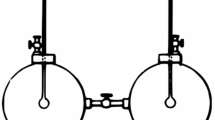Abstract
The state of a quantum system being described by a density operator ρ, quantum statistical mechanics calls the quantity −kTr(ρlnρ), introduced by von Neumann, its von Neumann or statistical entropy. A 1999 Shenker’s paper initiated a debate about its link with the entropy of phenomenological thermodynamics. Referring to Gibbs’s and von Neumann’s founding texts, we replace von Neumann’s 1932 contribution in its historical context, after Gibbs’s 1902 treatise and before the creation of the information entropy concept, which places boundaries into the debate. Reexamining von Neumann’s reasoning, we stress that the part of his reasoning implied in the debate mainly uses thermodynamics, not quantum mechanics, and identify two implicit postulates. We thoroughly examine Shenker’s and ensuing papers, insisting upon the presence of open thermodynamical subsystems, imposing us the use of the chemical potential concept. We briefly mention Landau’s approach to the quantum entropy. On the whole, it is shown that von Neumann’s viewpoint is right, and why Shenker’s claim that von Neumann entropy “is not the quantum-mechanical correlate of thermodynamic entropy” can’t be retained.
Similar content being viewed by others
References
Balian, Roger. 1982, Du Microscopique au Macroscopique. Ellipses, Paris. Vol. 1, Eng. edn. : 1991. From Microphysics to Macrophysics, Methods and Applications of Statistical Physics. Springer, Berlin, Vol. 1
Butterfield, Jeremy and John Earman. 2007. Handbook of the Philosophy of Sciences, edited by Gabbay, D.M., P. Thagard and J. Woods, Philosophy of Physics, Part. B, edited by J. Butterfield and J. Earman. Elsevier
Bruhat, Georges. 1962. Thermodynamique, 5th edn., totally reorganized by Alfred Kastler, Masson, Paris
Callen, Herbert B. 1966. Thermodynamics. 6th edn. Wiley, New York
Denis, Eric and Travis Norsen. 2004. Quantum Theory : Interpretation Cannot be Avoided, arXiv:quant-ph/0408178v1
Dirac, Paul A.M. 1930. The principles of quantum mechanics. Oxford University Press, London
Einstein, Albert. 1914. Beiträge zur Quantentheorie. Deuts. Phys. Gesell. Verhand. 16 : 820–828
Feshbach, Herman. 1987. Small systems : when does thermodynamics apply? Phys. Today 30 : 9–11
Feynman, Richard P. 1972. Statistical Mechanics W.A. Benjamin, Reading (USA)
Fuchs, Christopher A. and Asher Peres. 2000. Quantum theory needs no “interpretation”, Phys. Today 53 : 70–71
Gibbs, Josiah W. 1875. On the Equilibrium of Heterogeneous Substances. Trans. Con. Acad. 3 : 108–248 (Oct. 1875–May 1876) and 343-524 (May 1877–July 1878)
Gibbs, Josiah W. 1902. Elementary Principles in Statistical Mechanics developed with especial reference to the rational foundation of thermodynamics. Scribner’s sons, New York
Hagar, A. 2004. Chance and time, thesis, University of British Columbia
Hemmo, Meir and Orly Shenker. 2006. Von Neumann’s entropy does not correspond to thermodynamic entropy. Phil. Sci. 73 : 153–174
Henderson, Leah. 2003. The Von Neumann entropy : a reply to Shenker. Br. J. Phil. Sci. 54 : 291–296
Jaynes, Edwin T. 1957a. Information theory and statistical mechanics. Phys. Rev. 106 : 620–630
Jaynes, Edwin T. 1957b. Information theory and statistical mechanics II. Phys. Rev. 108 : 171–190
Jaynes, Edwin T. 1965. Gibbs versus Boltzmann entropies. Amer. J. Phys. 33 : 391–398
Jaynes, Edwin T. 1992. Maximum Entropy and Bayesian Methods, edited by C.R. Smith, G.J. Erickson, P.O. Neudorfer, Kluwer Academic Publishers, Dordrecht, Holland, p. 1–22
Jaynes, Edwin T. 2003. Probability Theory. Cambridge University Press, New York
Kittel, C. 1969. Thermal Physics. Wiley, New York
Landau, Lev D. and Evgeny M. Lifchitz. 1958. Course of Theoretical Physics. Statistical Physics. Engl. transl. Pergamon Press, London, Vol. 5
Landau, Lev D. and Evgeny M. Lifchitz. 1967. Course of Theoretical Physics, Mécanique Quantique, Théorie non relativiste, French edn. : Mir Publishers, Moscow, Vol. 3
Lebowitz, Joel L. 2007. From Time-Symmetric Microscopic Dynamics to Time-Asymmetric Macroscopic Behavior : An Overview. Boltzmann’s Legacy – Proceedings of Vienna Conference on Boltzmann, pp. 63–89, arXiv:0709.0724v1
Lebowitz, Joel L. 2010. Approach to thermal equilibrium of macroscopic quantum systems, Phys. Rev. E 81 : 011109, 1-9
Messiah, Albert. 1965. Mécanique Quantique. Dunod, Paris, Vol. 1
Nielsen, Michael A. and Isaac L. Chuang. 2000. Quantum Computation and Quantum Information. Cambridge University Press, Cambridge
Penrose, Oliver. 1979. Foundations of statistical mechanics, Rep. Prog. Phys. 42 : 1937–2006
Peres, Asher. 2002. Quantum Theory : Concepts and Methods. 2nd edn. Kluwer Academic Publishers, Dordrecht
Poincaré, Henri. 1902. La Science et l’Hypothèse, Flammarion. Paris. Reprint : 1992. Editions de la Bohème, Rueil-Malmaison
Poincaré, Henri. 1908. Thermodynamique, Gauthier-Villars. Paris, 2nd edn. Reprint : 1995. Editions Jacques Gabay, Paris
Reif, Frederick. 1965. Fundamental of Statistical and Thermal Physics. McGraw Hill Kogakusha, Tokyo
Shannon, Claude E. 1948. A Mathematical Theory of Communication. Bell Syst. Tech. J. 27 : 379–423 and 623-656
Shenker, Orly R. 1999. Is −kTr(ρlnρ) the Entropy in Quantum Mechanics? Br. J. Phil. Sci. 50 : 33–48
Sommerfeld, Arnold. 1950. Thermodynamics and Statistical Mechanics, Engl. trans., Academic Press, San Diego. (Chap. 1, Sec. 4 distinguishes between the use of the word energy by Aristotle and its introduction into the language of science by Rankine (1853))
Von Neumann, John. 1932. Mathematische Grundlagen der Quantenmechanik. Berlin : Springer. Engl. transl. 1955. Mathematical Foundations of Quantum Mechanics. Princeton University Press, Princeton
Author information
Authors and Affiliations
Corresponding author
Rights and permissions
About this article
Cite this article
Deville, A., Deville, Y. Clarifying the link between von Neumann and thermodynamic entropies. EPJ H 38, 57–81 (2013). https://doi.org/10.1140/epjh/e2012-30032-0
Received:
Revised:
Published:
Issue Date:
DOI: https://doi.org/10.1140/epjh/e2012-30032-0




